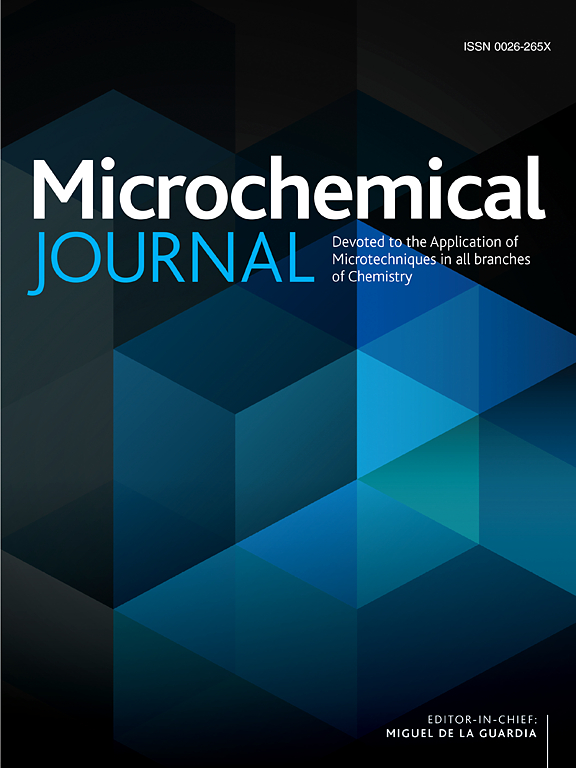A novel dual-color glucose detection method based on G-quadruplex DNAzyme catalytic properties: Utilizing ABTS2− and acid violet 7 for high sensitivity and visual semi-quantitative analysis
IF 4.9
2区 化学
Q1 CHEMISTRY, ANALYTICAL
引用次数: 0
Abstract
A novel dual-color method for glucose detection has been devised, leveraging the combination of 2,2′-azino-bis(3-ethylbenzothiazoline-6-sulfonic acid) diammonium (ABTS2−) and acid violet 7, based on the catalytic properties of G-quadruplex DNAzymes. In the presence of K+, the oligonucleotide 5′-GTGGGTAGGGCGGGTTGG-3′ (PS2.M) forms a G-quadruplex structure. When bound to hemin, this structure mimics horseradish peroxidase (HRP) and catalyzes the oxidation of colorless ABTS2− to green ABTS•− by H2O2. The H2O2 is produced through the reaction between glucose and oxygen, catalyzed by glucose oxidase. By linking these two reactions, the oxidation of glucose can be translated into a color change in ABTS2−. Under optimal conditions, the absorbance at 420 nm (A420 nm) is directly proportional to the glucose concentration within a range of 1.0 μM to 40.0 μM. The linear regression equation is A = 0.175 + 0.0334C (C: μM, R = 0.998), with a detection limit of 0.1 μM (3σ/slope). Furthermore, the introduction of acid violet 7 as a reference molecule enables the green color intensity change to be transduced into a color transition from red to gray and then to green, facilitating high-resolution semi-quantitative analysis of glucose by visual inspection. Importantly, our proposed method has been validated through its application to the detection of glucose concentrations in human serum, yielding promising results that underscore its potential for clinical diagnostics and research applications. Our findings represent a substantial advancement in the field of glucose detection and offer a promising alternative to existing methods.

一种基于g -四联DNAzyme催化性质的双色葡萄糖检测新方法:利用ABTS2 -和酸性紫7进行高灵敏度和视觉半定量分析
基于g -四联DNAzymes的催化性质,设计了一种新的双色葡萄糖检测方法,利用2,2 ' -氮基-双(3-乙基苯并噻唑-6-磺酸)二铵(ABTS2 -)和酸紫7的组合。在K+存在下,寡核苷酸5 ' -GTGGGTAGGGCGGGTTGG-3 ' (PS2.M)形成g -四重结构。当与血红蛋白结合时,该结构模拟辣根过氧化物酶(HRP),并催化H2O2将无色ABTS2 -氧化为绿色ABTS•-。H2O2是由葡萄糖氧化酶催化葡萄糖与氧气反应产生的。通过连接这两个反应,葡萄糖的氧化可以转化为ABTS2−的颜色变化。在最佳条件下,在1.0 μM ~ 40.0 μM范围内,420 nm处(A420 nm)吸光度与葡萄糖浓度成正比。线性回归方程为A = 0.175 + 0.0334C (C: μM, R = 0.998),检出限为0.1 μM (3σ/斜率)。此外,引入酸紫7作为参考分子,可以将绿色强度变化转换为从红色到灰色再到绿色的颜色转换,从而便于通过目测对葡萄糖进行高分辨率半定量分析。重要的是,我们提出的方法已经通过其在人类血清中葡萄糖浓度检测中的应用得到了验证,产生了有希望的结果,强调了其在临床诊断和研究应用中的潜力。我们的发现代表了葡萄糖检测领域的重大进步,并为现有方法提供了一个有希望的替代方案。
本文章由计算机程序翻译,如有差异,请以英文原文为准。
求助全文
约1分钟内获得全文
求助全文
来源期刊

Microchemical Journal
化学-分析化学
CiteScore
8.70
自引率
8.30%
发文量
1131
审稿时长
1.9 months
期刊介绍:
The Microchemical Journal is a peer reviewed journal devoted to all aspects and phases of analytical chemistry and chemical analysis. The Microchemical Journal publishes articles which are at the forefront of modern analytical chemistry and cover innovations in the techniques to the finest possible limits. This includes fundamental aspects, instrumentation, new developments, innovative and novel methods and applications including environmental and clinical field.
Traditional classical analytical methods such as spectrophotometry and titrimetry as well as established instrumentation methods such as flame and graphite furnace atomic absorption spectrometry, gas chromatography, and modified glassy or carbon electrode electrochemical methods will be considered, provided they show significant improvements and novelty compared to the established methods.
 求助内容:
求助内容: 应助结果提醒方式:
应助结果提醒方式:


